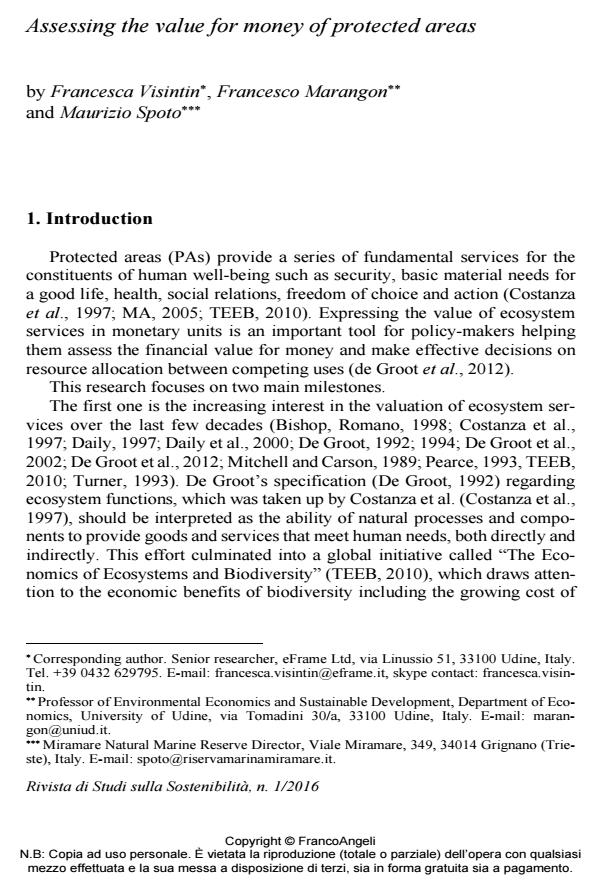Assessing the value for money of protected areas
Journal title RIVISTA DI STUDI SULLA SOSTENIBILITA'
Author/s Francesca Visintin, Francesco Marangon, Maurizio Spoto
Publishing Year 2016 Issue 2016/1
Language Italian Pages 21 P. 49-69 File size 272 KB
DOI 10.3280/RISS2016-001006
DOI is like a bar code for intellectual property: to have more infomation
click here
Below, you can see the article first page
If you want to buy this article in PDF format, you can do it, following the instructions to buy download credits

FrancoAngeli is member of Publishers International Linking Association, Inc (PILA), a not-for-profit association which run the CrossRef service enabling links to and from online scholarly content.
The increasing unavailability of public financing leads decision-makers to cut funds for protected areas without considering the ensuing environmental, economic and social impacts. The research investigated what and how much value the Miramare Natural Marine Reserve (Italy) was able to create from public funds. The environmental accounting approach was adopted, and environmental costs and benefits taken into account. Environmental benefits assessed ecosystem services such as gas regulation, nutrient cycling, biological control, food production, nursery, raw materials, recreation and science. The model demonstrated that the value produced by the Protected Area fully covered the money spent by public authorities by a rate of 2.5.
La crescente indisponibilità di risorse mette gli amministratori pubblici nella condizione di dover ridurre il finanziamento destinato alle aree protette. Il presente studio si pone l’obiettivo di valutare la ricchezza prodotta dall’Area marina protetta di Miramare (AMPM) a fronte del finanziamento ministeriale erogato. A tal fine è stato adottato un modello di contabilità ambientale che da evidenza dei benefici ambientali prodotti dall’AMPM. Tale stima si traduce nella valutazione monetaria dei servizi ecosistemici, tra i quali: gas regulation, nutrient cycling, biological control, food production, nursery, raw materials, recreation e science. Il modello così sviluppato dimostra che la ricchezza prodotta dall’AMPM si pone in un rapporto di 2,5 rispetto al finanziamento pubblico erogato.
Keywords: Marine protected area, environmental accounting, ecosystem service
- Disaster-related losses of ecosystems and their services. Why and how do losses matter for disaster risk reduction? Yvonne Walz, Sally Janzen, Liliana Narvaez, Andrea Ortiz-Vargas, Jacob Woelki, Nathalie Doswald, Zita Sebesvari, in International Journal of Disaster Risk Reduction 102425/2021 pp.102425
DOI: 10.1016/j.ijdrr.2021.102425 - Environmental values and willingness to pay for a protected area: a segmentation of Italian university students M. B. Forleo, L. Romagnoli, N. Palmieri, in International Journal of Sustainable Development & World Ecology /2019 pp.45
DOI: 10.1080/13504509.2018.1488298
Francesca Visintin, Francesco Marangon, Maurizio Spoto, Assessing the value for money of protected areas in "RIVISTA DI STUDI SULLA SOSTENIBILITA'" 1/2016, pp 49-69, DOI: 10.3280/RISS2016-001006